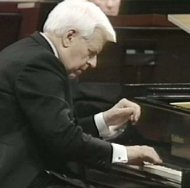Ralph Votapek - Ivory Classics
Ralph Votapek - Ivory Classics
Ralph Votapek - Ivory Classics
Create successful ePaper yourself
Turn your PDF publications into a flip-book with our unique Google optimized e-Paper software.
<strong>Ralph</strong><br />
<strong>Votapek</strong><br />
Music by<br />
Ginastera, Poulenc,<br />
Szymanowski & Piazzolla
<strong>Ralph</strong> <strong>Votapek</strong><br />
Music by Ginastera, Poulenc, Szymanowski and Piazzolla<br />
Alberto Ginastera (1916-1983)<br />
Alberto Evaristo Ginastera was born in Buenos Aires, April 11,<br />
1916. From early childhood he showed interest in music, beginning<br />
formal studies when he was seven years old. At twelve he entered the<br />
Conservatorio Williams, eventually entering the National<br />
Conservatory of Music where his teachers included Athos Palma<br />
and Jose Andre. His first mature work, the score for the ballet<br />
Panambi, was also the first he allowed to survive. The suite from the<br />
ballet was premiered in 1937 and the complete ballet was introduced<br />
at the Teatro Colon in 1940. Primitive in its rhythms and<br />
modern harmonies, the score constantly reveals the composer’s<br />
interest in a national Argentine idiom. During this time he also<br />
wrote the wonderful piano work, Danzas Argentinas. In 1938 he<br />
graduated with honors from the National Conservatory. In 1941 he<br />
was commissioned the ballet Estancia, and his first symphony,<br />
Sinfonia Portena followed in 1942. In 1942 he received a<br />
Alberto Ginastera<br />
Guggenheim Fellowship and he visited the United States. World<br />
War II inspired his Twelve American Preludes for piano and the<br />
Elegiac Symphony (1944), dedicated to those who “died for freedom.” From 1945-1947 he lived in<br />
New York. In 1948 he became director of the conservatory of the province of Buenos Aires in La<br />
Plata. In 1948 he completed another important work — his first string quartet.<br />
Ginastera’s Piano Sonata No.1 (1952) and the Variaciones Concertantes (1953) followed. Because<br />
of his pronounced anti-Fascist sentiments, Ginastera became increasingly suspect in Argentina during<br />
the Peron regime. Finally, in 1952, he was dismissed as director of the Conservatory of Music and<br />
Drama which he had founded. Compelled to earn his living elsewhere, he took to writing motion<br />
picture scores. In 1955, with the overthrow of the Peron regime, Ginastera was restored to his<br />
Conservatory post — where he remained until 1958 when he resigned to become director of the new<br />
Facultad de Ciencias y Artes Musicales of the Catholic University. His Piano Concerto was premiered<br />
in Washington, D.C. in 1959 and for the opening season of the New York Philharmonic at<br />
– 2 –
the Lincoln Center for the Performing Arts, Ginastera was commissioned to write a violin concerto.<br />
Ruggiero Ricci introduced it with Leonard Bernstein conducting on October 2, 1963. Ginastera’s<br />
opera Don Rodrigo was performed by the New York City Opera in 1966. His next opera Bomarzo<br />
(1967) was an extraordinary success. Its overt sexuality prompted one critic to label it “Porno in<br />
Belcanto.” In 1971 he wrote his third opera, Beatrix Cenci and in 1972 his Second Piano Concerto was<br />
introduced by pianist Hilde Somer with the Indianapolis Symphony Orchestra. His second and third<br />
piano sonatas were written in 1981-1982, his cello sonata in 1979 and his cello concertos in 1968<br />
and 1980. Additionally, Ginastera wrote two other string quartets, No.2 in 1958 and No.3 in 1973.<br />
Alberto Ginastera died in Geneva, Switzerland on June 25, 1983.<br />
Sonata No.1, Opus 22 was composed in 1952 for the Pittsburg Contemporary Music Festival on<br />
a commission from the Carnegie Institute and the Pennsylvania College for Women. Johana Harris,<br />
pianist-wife of the American composer, Roy Harris, gave the premiere on November 29, 1952. The<br />
composer provided the following notes: “The Piano Sonata is divided into four movements. The first<br />
one, Allegro marcato, corresponds to the plan of the sonata-form with two main themes: the first one<br />
is built upon complex rhythmic cells while the second has a melodic character. The second movement<br />
has the structure of a scherzo in three parts whose main theme arises from a row. The whole movement<br />
is played pianissimo and has strange sonorities. The third movement, Adagio molto appassionato,<br />
corresponds to the form of a three-part Lied (song). The theme in the first and third parts appears<br />
as a lyric improvisation, the second being of a passionate character. The fourth movement, Ruvido ed<br />
ostinato (“Rough and Obstinate”), is built in the form of a rondo in five parts with the style and technique<br />
of a toccata. This movement is built on a rhythmic line which changes constantly within a fixed<br />
structure.”<br />
Francis Poulenc (1899-1963)<br />
Francis Poulenc was a true “musicien francais,” which is to say, of course, that Poulenc’s music<br />
is bound to be a bit inexplicable to those of us who listen with non-French ears. We won’t have any<br />
trouble enjoying it. Poulenc is as persuasive as Piaf, as mellifluous as Melarchino and mostly about<br />
as modern as Mendelssohn. No twelve-tone implications here! No language of dissonance (not a<br />
consistent and logical dissonant language, anyhow). Poulenc was once a radical shocker. But, even<br />
in 1960, his dissonance remained that of the snazzy musical revolution of the 1920’s, now verging<br />
upon the quaint for our case-hardened ears. And the Poulencian consonance is that of the later<br />
1930’s, when “modern” music permitted itself to relax, for awhile, and plain, old-fashioned<br />
C major chords were once again heard — somewhat to everyone’s relief. That time, too, is<br />
– 3 –
now gone. But in the 1960’s Poulenc was still there.<br />
Born in 1899 in Paris, Poulenc wrote his first piano compositions<br />
in early 1917. In 1919 the concert audiences heard his three<br />
Mouvements Perpetuels and Poulenc became a household name<br />
almost overnight. He then joined a group of French composers<br />
(along with Milhaud, Durey, Auric, Honegger and Tailleferre)<br />
called “The French Six.” In 1924 Sergei Diaghilev commissioned<br />
Poulenc to write a score for the Ballet Russe, and the result was Les<br />
Biches (“The Does”). The ballet was a great success. One critic<br />
wrote: “The Poulenc score is exquisite... With its ironic and slightly<br />
rakish twists, its thoroughly traditional elegance of thought, it goes<br />
straight to the point, its one aim being to bring delight.”<br />
Many works followed — the Concert Champetre, a Concerto for<br />
Two Pianos and Orchestra, the Mass in G Major, songs, chamber<br />
music and, of course, more piano pieces. During World War II,<br />
Poulenc was an active member of the French Resistance movement.<br />
Francis Poulenc<br />
Works from these years include the poignant Violin Sonata dedicated<br />
to the memory of Federico Garcia Lorca and the deeply moving,<br />
tragic choral work, Figure Humaine. In 1957 he produced the opera Les Dialogues des Carmelites,<br />
which received its American premiere at the San Francisco Opera on September 22, 1957. In 1959<br />
he produced La Voix Humaine, and in 1961 the six-part Gloria for chorus and orchestra. Francis<br />
Poulenc died suddenly at his home in Paris on January 30, 1963.<br />
Critic Jay Harrison once stated that, “In many ways, Poulenc is Paris. He is gay like Paris, sad like<br />
Paris. And he bustles constantly. His hands wave, his eyebrows arch, he twitches, grins, makes faces.<br />
When his mouth talks, all of him talks too. If he is not Paris, he is at least French. Not even a deaf<br />
man could doubt that.” And certainly that is also true of Poulenc’s music. Poulenc’s eight nocturnes<br />
span about a decade (1929-1938). Although they are often played separately, Poulenc created a<br />
“cycle” when he composed the eighth nocturne and titled it “Pour servir de Coda au Cycle” (“To serve<br />
as the Coda for the Cycle”). Unlike Chopin’s or Faure’s, Poulenc’s nocturnes are not romantic tonepoems.<br />
They are instead “night-scenes” and “sound-images” of public and private events.<br />
The first Nocturne, in C major, acts as a prelude to the set. It is typically Poulenc — constructed<br />
out of a touching, almost child-like melodic pattern, with some Stravinskian style touches and a weird<br />
epilogue marked, “le double plus lent.” The second Nocturne is entitled “Bal de jeunes filles.”<br />
– 4 –
The young girls, in Poulenc’s world, are indulging in a quadrille, a dance with both military and theatrical<br />
associations. According to biographer Wilfrid Howard Mellers, this Nocturne “is a delicious<br />
Poulenc image for the vulnerability of youth, perhaps even the vanity of human wishes.” The third<br />
Nocturne, is entitled “Les Cloches de Malines.” Mellers sees this as a different kind of genre-piece “for<br />
it aurally depicts a small-town market-square that is probably, at dead of night, destitute of people.<br />
Bells toll through fourths between F and C, played by the left hand in equal crotchets but irregular<br />
metre, as though the mechanism is defective. It may well be, since the bells are very old, being in one<br />
of Poulenc’s ‘antique’ pieces — with the proviso that its world, however ancient, is still extant... the<br />
cacophony that eventually forms a brief middle section has a programmatic intention... perhaps the<br />
frantic clangings warn of some disaster, or maybe the clock’s works have gone crazy. In any case, we<br />
hear the raucous chaos in psychological as well as physical terms: the hubbub is the ills that flesh is<br />
heir to, the slings and arrows of outrageous fortune, things that go bump in the night.”<br />
The fourth Nocturne, “Bal fantôme” carries a quotation by Julien Green:<br />
“Pas une note des valses ou des scottisches ne se perdait<br />
dans toute la maison, si bien que le malade eut sa part de<br />
la fête et put rêver sur son grabat aux bonnes années de<br />
sa jeunesse.”<br />
We are led by Poulenc through an old-world, “phantom ball” where the chromatic harmony, sensuously<br />
spaced, moves us through a by-gone-era waltz. It is dream-like, seductive and welcoming. The<br />
fifth Nocturne is entitled “Phalènes” (“Moths”). In this Presto misterioso, Mellers hears the moths<br />
flickering in an iridescent bitonality. It is one Poulenc’s more pictorial pieces — the coda is a quivering,<br />
sepulchral bit of music, which Mellers feels may signal a human allegory: “we may be moths, jittering<br />
directionless.”<br />
We are again outdoors for the sixth Nocturne. Mellers sees the work as “wafting through darkness.”<br />
In the seventh Nocturne, our “jeunes filles” are back dancing or strolling on a balmy summer<br />
night. According to Mellers, “since the young girls are recalled in the seventh Nocturne, it makes sense<br />
that Poulenc should round off the cycle with an epilogue.” The eighth Nocturne is designated<br />
“Nocturne pour servir de Coda au Cycle.” It begins with a tune close to that of the first Nocturne,<br />
but in 3/4 instead of 4/4. Mellers sees this as “a positive evolution... the music modulates flatwards<br />
ending on bare fifths of C, so the tonic C basic to the suite is reinstated, but not strongly affirmed.<br />
Fallibly human, Poulenc mistrusted definitive answers. This delectable suite of eight Nocturnes<br />
– 5 –
displays the loving care with which Poulenc defined, and protected,<br />
his vulnerabilities, even though they are less patent than<br />
those of the jeunes filles.”<br />
Karol Szymanowski (1883-1937)<br />
Karol Szymanowski was born in Tymoszowka, near<br />
Elisavetgrad, in the Ukraine, on September 21, 1883. His<br />
father was a wealthy Polish landowner who made his home a<br />
gathering place for the cultural elite. As a result, the young boy<br />
was surrounded in childhood with literature, music and art.<br />
Music and the piano attracted him and eventually a local<br />
teacher was hired to teach him theory. In 1900 he published his<br />
first works, a set of piano preludes which prompted the one<br />
critic to write, “The lyric sincerity, the charming poetic ideas,<br />
the beauty of melodic invention, the harmonic variety and,<br />
finally, the elegance of technique and finesse commanded universal<br />
attention.” His talent now required serious nurturing,<br />
Karol Szymanowski<br />
and Karol Szymanowski was sent to Warsaw in 1903 to study<br />
with Zygmunt Noskowski. Under Noskowski, he worked<br />
industriously at counterpoint as well as in the free forms of composition. A sonata for piano composed<br />
in 1905 under Noskowski’s guidance, won first prize in a Chopin competition held in<br />
Lemberg. That year, he moved to Berlin, where he fell under the spell of the composers Richard<br />
Strauss, Gustav Mahler and Anton Bruckner.<br />
In 1906 he composed his First Symphony, still under the influence of German Romanticism.<br />
After he left Germany in 1908, Szymanowski’s style became more subjective, filled with restless<br />
moods and dramatic expositions. Examples from this period were his Second Symphony and Second<br />
Piano Sonata. A prelude and fugue, written in 1909, won a prize in a competition instituted by the<br />
Berlin Signale für die musikalische Welt. Szymanowski did not feel completely comfortable with the<br />
direction his music was taking and turned next to exotic idioms. Szymanowski much admired the<br />
compositions of Alexander Scriabin and became also interested in mysticism and oriental philosophy.<br />
The resulting music he produced was filled with the atmosphere and colors of the East: the<br />
opera Hagith (1913), the Love Songs of Hafiz (1914), and the Third Symphony, “The Song of<br />
the Night” (1916).<br />
– 6 –
The Russian Revolution had far-reaching repercussions for Szymanowski. His family estates in<br />
both Poland and the Ukraine were plundered and all the family belongings were confiscated by the<br />
Bolsheviks. Destitute, he settled in Warsaw and managed to eke out a living through his music, concertizing<br />
when opportunities presented themselves, in Paris, London, and the United States. After the<br />
war, Szymanowski spent a few months in the Tatra Mountains of Poland, where he heard native songs<br />
and dances. This experience inspired him to utilize these native idioms in his compositions. “Today,”<br />
he wrote, “I have developed into a national composer, not only subconsciously but with a thorough<br />
conviction, using the melodic treasures of the Polish folk.” His ballet, Harnasie (1926), was based on<br />
a Polish legend from the Tatra mountains. Also in 1926, Szymanowski was appointed director of the<br />
Warsaw Conservatory. Ill-health began to plague him and in 1929 he suffered a nervous breakdown.<br />
He resigned his academic post and checked himself in at a sanitarium near Lausanne, Switzerland.<br />
He continued to compose creating his Symphonie Concertante for piano and orchestra, Opus 60 and<br />
his Violin Concerto No.2, Opus 61. He took on the responsibilities of president of the Academy of<br />
Music in Warsaw, but a relapse sent him back to Switzerland where he died on March 28, 1937 of<br />
laryngeal tuberculosis.<br />
Szymanowski composed the three piano tone-poems, Masques, Opus 34 in 1915-16. They were<br />
first played on October 12, 1916 in St. Petersburg by Sascha Dubiansky. The first poem,<br />
“Sheherazade,” which is dedicated to Dubiansky evokes the orientalism and imagery of A Thousand<br />
and One Nights. “Tantris the Clown” is based on Ernst Hardt’s poem. Dedicated to Heinrich<br />
Neuhaus, this work is a warped version of the Tristan legend. According to Artur Rubinstein,<br />
“Tristan, under this false name [an anagram] tries to steal into Isolde’s apartment one night but is<br />
readily recognized by the dogs and arouses the suspicions of the household.” “Don Juan’s Serenade”<br />
was dedicated to Artur Rubinstein. It is a work that begins in a quasi-improvisational vein, growing<br />
impassioned and urgent, with fits of ecstasy. This is an ardent work, full of, according to biographer<br />
Eduard Volynski, “soul and heart.”<br />
Astor Piazzolla (1921-1992)<br />
Following a long struggle against illness, composer and musician Astor Piazzolla died on<br />
Saturday, July 4, 1992, at the age of 71. He had plunged into a deep coma following a stroke suffered<br />
in Paris on August 5th, 1990. He was never to compose or play again, and in the months preceding<br />
his death, he was already being spoken of in Buenos Aires in the past tense. The tunes and<br />
works of Astor Piazzolla will remain, inscribed forever on the walls of the temple of the tango, just<br />
below those of the unforgettable Carlos Gardel. All tango lovers agree that there was a “before” and<br />
– 7 –
“after” Piazzolla. “He revolutionized the tango,” writes<br />
Marikena Monti, “Giving the tango emotion and mystery...<br />
He discovered a different new rhythm, pure tango, yet different.<br />
It was a real miracle.”<br />
Piazzolla reinvented the tango, bringing to it influences<br />
from classical, jazz, and Argentinean folk music. He was<br />
born in 1921 in Mar del Plata and was educated in New<br />
York until the age of 15. He played classical piano, until one<br />
day when his father gave him a bandonéon. “I was 10 years<br />
old,” he said. “If he’d bought me a saxophone I’d have<br />
played jazz. But it was the tango that won.” While in the<br />
United States he met his idol Carlos Gardel who had<br />
already noticed this little prodigy. Back in Buenos Aires<br />
Piazzolla played in orchestras and composed, but was considered<br />
an “intellectual” of the tango by the Porteños,<br />
always reluctant to accept innovation in their tango<br />
Astor Piazzolla<br />
domain. Piazzolla eventually travelled the world and<br />
became one of the most famous Argentineans outside<br />
Argentina. During the 1960’s he gained popular recognition in his homeland with what were to<br />
become his two best-known compositions: the dramatic and sorrowful Adiós Nonino written to commemorate<br />
the death of his father and Balada para un loco (“Ballad For a Madman”), the result of his<br />
long collaboration with the poet Horacia Ferrer. In 1985 he composed the History of the Tango. The<br />
work is in four parts depicting a particular moment in the evolution of the dance. The two tangos<br />
selected by <strong>Ralph</strong> <strong>Votapek</strong> are less often heard, but just as compelling. Lo Que Vendrá (“That Which<br />
is Coming”) was composed in 1957, two years after Piazzolla had studied with Nadia Boulanger. This<br />
piano tango is one of his earliest “infused” works, drawing upon the rhythms of the traditional dance<br />
in combination with jazz elements and classical counterpoint and ornamentation of Bach’s time.<br />
Retrato de Alfredo Gobbi was composed in 1970 and is a portrait (retrato) of a musical friend.<br />
– 8 –<br />
— Marina and Victor Ledin, ©1998
<strong>Ralph</strong> <strong>Votapek</strong><br />
– 9 –
<strong>Ralph</strong> <strong>Votapek</strong> Biography<br />
<strong>Ralph</strong> <strong>Votapek</strong> was born in Milwaukee in 1939 and began his musical studies in Milwaukee’s<br />
Wisconsin Conservatory at the age of nine. He studied at Northwestern University with Guy<br />
Mombaerts, earning his Bachelor’s Degree, and subsequently attended the Manhattan School of<br />
Music and the Juilliard School. His principal teachers were Rosina Lhevinne and Robert Goldsand.<br />
In 1959, he won the Naumburg Award which gave him his New York debut at Town Hall. Mr.<br />
<strong>Votapek</strong> skyrocketed to world prominence when he won the Gold Medal of the First Van Cliburn<br />
International Piano Competition in 1962. The prize brought with it a $10,000 check, headlines<br />
around the world, a Carnegie Hall debut recital, a contract with famed impresario Sol Hurok, and<br />
an RCA Victor recording contract.<br />
Since 1962, <strong>Votapek</strong> has maintained a front-rank position among pianists. After the Van<br />
Cliburn Competition prize, <strong>Votapek</strong> scored a tremendous success in London with the<br />
Philharmonia and was hailed for his performances across the United States. In 1966, he made his<br />
first tour of South America, where his reputation among young audiences in Buenos Aires was compared<br />
to those of the “ye-ye” idols. At the famous Colon Theatre they mobbed him, chanting,<br />
“<strong>Ralph</strong>ie, <strong>Ralph</strong>ie.” Mr. <strong>Votapek</strong> has a special commitment to South America, where he has toured<br />
every other year for the past three decades. In August 1997, the Buenos Aires Herald said, “<strong>Votapek</strong>,<br />
now in his fifties, keeps his characteristic boyishness; handsome, dynamic and ingratiating, he communicates<br />
easily. Artistically he is as consistent as they come; a rock-solid technique, a catholicity<br />
of taste that knows no bounds, and beautifully varied and interesting programs. You’ll never be disappointed<br />
in a <strong>Votapek</strong> recital.”<br />
He has appeared with virtually all the major American orchestras and has been partnered by<br />
such legendary conductors as Rafael Kubelik, William Steinberg, Joseph Krips and Erich Leinsdorf.<br />
He has been guest soloist sixteen times with the Chicago Symphony Orchestra and has appeared<br />
frequently with the Los Angeles, Pittsburgh, San Francisco, Washington D.C., Boston Pops, Saint<br />
Louis, Houston, Dallas and Louisville orchestras.<br />
Equally at home in chamber music, Mr. <strong>Votapek</strong> has performed with the Juilliard, Fine Arts,<br />
New World and Chester String Quartets. The PBS television network and other educational stations<br />
in the U.S. broadcast frequently Mr. <strong>Votapek</strong>’s video series of forty recitals.<br />
Mr. <strong>Votapek</strong> has the title of Artist-in-Residence at Michigan State University in East Lansing.<br />
– 10 –
Credits<br />
Recorded at the WFMT Studios, Chicago, July 28-29, 1997<br />
Recording Engineer: Lawrence Rock<br />
Editor: John McDaniel<br />
Executive Producer: Michael Rolland Davis<br />
Mastered by: Ed Thompson<br />
Piano: Steinway & Sons, New York<br />
Cover and Inside Tray Card Photos:<br />
Arnaldo Colombaroli (Teatro Colon, Buenos Aires, Argentina)<br />
Liner Notes: Marina and Victor Ledin<br />
Design: Communication Graphics<br />
To be included on mailing list, or<br />
receive information on <strong>Ivory</strong> <strong>Classics</strong> , contact:<br />
<strong>Ivory</strong> <strong>Classics</strong> P.O. Box 341068 • Columbus, Ohio 43234-1068<br />
Phone: 1-888-40-IVORY • Fax: 614-761-9799<br />
e-mail@ivoryclassics.com • Website: www.<strong>Ivory</strong><strong>Classics</strong>.com<br />
– 11 –
<strong>Ralph</strong> <strong>Ralph</strong> <strong>Votapek</strong> <strong>Votapek</strong><br />
Music by Ginastera, Poulenc, Szymanowski & Piazzolla<br />
Alberto Ginastera: Sonata No.1, Opus 22 (1952) 14:57<br />
1 I. Allegro marcato 4:17<br />
2 II. Presto misterioso 2:40<br />
3 III. Adagio molto appassionato 5:07<br />
4 IV. Ruvido ed ostinato 2:53<br />
Francis Poulenc: Nocturnes (complete) 17:27<br />
5 No.1 in C Major (1929) – Sans traîner 3:01<br />
6 No.2 in A Major (1933) – Bal de jeunes filles<br />
Très animé 1:26<br />
7 No.3 in F Major (1934) – Les cloches de Malines<br />
Modéré mais sans lenteur 3:09<br />
8 No.4 in C minor (1934) – Bal fantôme<br />
Lent, très las et piano 1:31<br />
9 No.5 in D minor (1934) – Phalènes<br />
Presto misterioso 1:17<br />
10 No.6 in G Major (1934)<br />
Très clame mais san traîner 3:05<br />
11 No.7 in E flat Major (1935) – Assez allant<br />
12 No.8 (1938) – Pour servir de Coda au Cycle<br />
2:08<br />
Très modéré<br />
Karol Szymanowski:<br />
1:50<br />
Masques (3 Poems), Opus 34 (1916) 21:11<br />
13 I. Shéhérazade – Lento assai, languido 9:21<br />
14 II. Tantris le Bouffon – Vivace assai 5:59<br />
15 III. Sérénade de Don Juan – Vivace 5:51<br />
Astor Piazzolla: Two Tangos 5:58<br />
16 Lo Que Vendrá (1957) 2:49<br />
17<br />
Retrato de Alfredo Gobbi (1970) 3:09<br />
Total Playing Time: 60:40<br />
Recording Engineer: Lawrence Rock • Executive Producer: Michael Rolland Davis<br />
Mastered by: Ed Thompson • Piano: Steinway & Sons, New York<br />
1998 <strong>Ivory</strong> <strong>Classics</strong> • All Rights Reserved.<br />
<strong>Ivory</strong> <strong>Classics</strong> • P.O. Box 341068<br />
Columbus, Ohio 43234-1068 U.S.A.<br />
Phone: 1-888-40-IVORY • Fax: 614-761-9799<br />
e-mail@ivoryclassics.com • Website: www.<strong>Ivory</strong><strong>Classics</strong>.com<br />
64405-70804<br />
STEREO<br />
®














